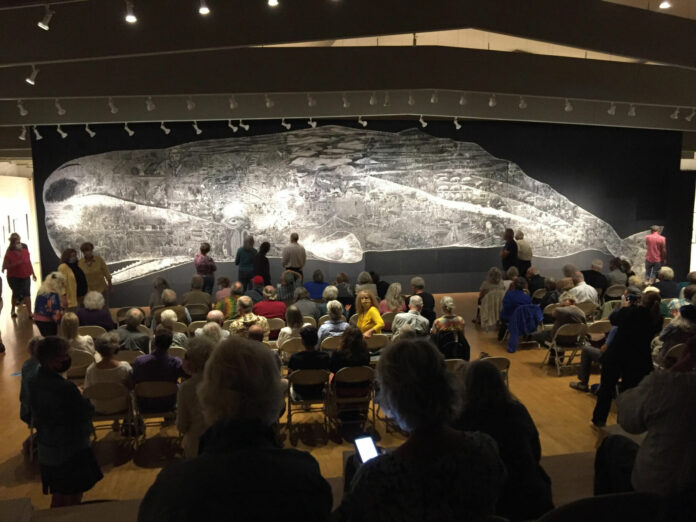Berkeley artist Jos Sances appeared before a sold-out crowd at Sebastopol Center for the Arts on Wednesday night, July 14, to discuss his work, “Or, The Whale,” which has been on display at the art center since its reopening on June 24.
July 14 was Bastille Day, which set an appropriately revolutionary tone for the discussion of a work that offers a kind of Howard Zinn-like people’s history of the United States. Inscribed on the body of the whale is a record of what Sances sees as the crimes of American capitalism — social and economic oppression and ecological destruction — combined with images of the grassroots resistance movements which rose up in response.
A radical reading of Moby Dick
Sances chose to begin his examination of American capitalism with the year 1850, when Herman Melville’s novel “Moby Dick” was published. (The subtitle of the novel is “Or, The Whale.”) Sances re-read the book, after a family whale-watching trip to the Sea of Cortez in Baja, a trip he said radically shifted his view of nature.
He sees the novel as a critique of capitalism and a description of the racial hierarchy that was already hardening in America by the middle of the 19th century.
“There’s many, many things that he tells you in the book that really leads you to make conclusions about what he’s talking about,” Sances said, noting that the ship is named “The Pequot,” after the first Native American tribe to be wiped out by the Pilgrims (and their native allies) in 1637.
“Why are the harpooners Native American and black and Polynesian?” he said. “Then there’s the white owners that never get on the boat and the white sailors who basically are the first and second mates and captain. The majority of the lower sailors on the boat are people of color. So there’s this hierarchy that comes through.”
The whale in Melville’s classic is much larger than the 52-feet-long by 14-feet-high leviathan depicted in “Or, The Whale.”
“This is actually the size of the female sperm whale. So actually this is Moby Jane,” Sances joked.
Capitalism as a trail of tears
“Or, The Whale” depicts the costs of the extractive industries that built the United States (and, one should note, most other industrialized countries): mining, logging, the oil industry, industrial agriculture and even the computer industry, which relies on rare earth metals and produces a river of e-waste.
The artwork can be read chronologically left to right, but there’s quite a lot of time slippage, as the illustrations veer from child miners in the 1850s to the massacre of the Pequots in 1637 to the famous Brooks’ illustration of slave ships (1788) and to the melting glaciers of today, appropriately drawn next to oil baron John D. Rockefeller. This mash-up quality doesn’t damage the integrity of the piece, but instead builds a network of connections that stitches the crimes of one era to the crises of another.
The villains of the piece are the captains of industry who loom, like indifferent gods, above the chaos depicted below: John D. Rockefeller, JP Morgan, Henry Ford, Leland Stanford and Steve Jobs.
Sances joked that he thinks of “Or, the Whale” as “a kind of a Mount Rushmore of capitalism.”
How “Or, The Whale” was created
“Or, the Whale” is comprised of 119 scratchboard panels. Scratchboard is an art medium, where the artist creates a drawing by scratching away the black ink on the surface to reveal the white kaolin clay and titanium-oxide layer underneath.
Before starting the piece, Sances created a detailed six-foot drawing of a sperm whale, which he used as a model. As a result, from a distance, “Or, the Whale” looks like a very accurate anatomical drawing of a whale. It’s only when you get up close that you see the thousands of other drawings etched into its body.
Sances said he did a looser drawing of a whale with all the topics and historical events he wanted to cover written in on different parts of the whale, then he searched for historical photos that served as iconic images to represent those issues.
Sances, who is better known as a printer and muralist, took eight months to complete “Or, the Whale,” which he worked on panel by panel, moving left to right. He noted in the lecture that all that drawing practice improved his style, and that the drawings on the right side of the whale are more finished and sophisticated than the drawings on the left.
His Berkeley studio was only big enough to put up six panels at a time, so he didn’t actually see the full piece until it was displayed in public for the first time.
The show at SebArts marks only the third time the piece has been shown in a gallery. “Or, The Whale” debuted at the Richmond Art Center in 2019, then traveled across the country to the museum at the University of Kansas. Now it’s in Sebastopol until July 24.
Did you miss Sances’ first talk? Here’s another chance: Sances will give another talk on “Or, The Whale” in English and Spanish at Sebastopol Center for the Arts on Tuesday, July 22 as part of another event, “The Great Tortilla Conspiracy.” Find out more at sebarts.org.
Townsy Sebastopol is a community web app, offering local news, online shopping at local stores, a local event guide, local volunteer and job boards and more. Find it at https://townsyapp.com.
SoCoNews is partnering with Townsy to make our news more accessible to the Sebastopol community.









